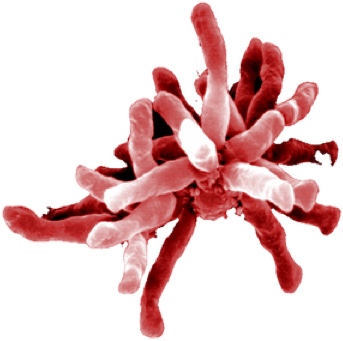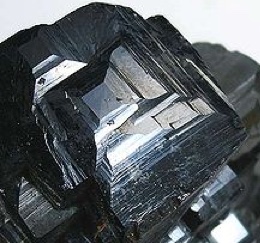How bacteria can use magnetic particles to create a ‘natural battery’
March 30, 2015

Rhodopseudomonas palustris bacteria (credit: Wikimedia Commons)
Iron-metabolizing bacteria can load electrons from microscopic particles of magnetite (magnetic iron oxides) and later, discharge electrons to the microparticles, which could lead to a new way to clean up environmental pollution and other bioengineering applications, an international team of researchers have found.
For example, using light energy, magnetite can reduce (gain electrons from) the toxic form of chromium, chromium VI, converting it to the less toxic chromium III, which can then be incorporated into a harmless magnetite crystal.
“In our study we only looked at iron-metabolizing bacteria, but we speculate that it might be possible for other non-iron metabolizing organisms to use magnetite as a battery as well, or they can be made to use it, through genetic engineering,” said study leader James Byrne from the University of Tübingen

Magnetite crystal (credit: Wikimedia Commons)
As the researchers note in the journal Science on March 27, they showed that in simulated daylight, phototrophic iron-oxidizing bacteria (Rhodopseudomonas palustris) removed electrons from the magnetite, thereby discharging it. At night, the iron-reducing bacteria (G. sulfurreducens) took over and were able to dump electrons back onto the magnetite and recharge it for the following cycle.
This oxidation/reduction (redox) mechanism was repeated over several cycles, meaning that the “battery” functioned over repeated day-night cycles. This could also work with other types of bacteria that do not normally require iron to grow, e.g., fermenters, the researchers suggest.
Scientists at the University of Manchester and Pacific Northwest National Laboratory were also involved in the research.
Abstract of Redox cycling of Fe(II) and Fe(III) in magnetite by Fe-metabolizing bacteria
Microorganisms are a primary control on the redox-induced cycling of iron in the environment. Despite the ability of bacteria to grow using both Fe(II) and Fe(III) bound in solid-phase iron minerals, it is currently unknown whether changing environmental conditions enable the sharing of electrons in mixed-valent iron oxides between bacteria with different metabolisms. We show through magnetic and spectroscopic measurements that the phototrophic Fe(II)-oxidizing bacterium Rhodopseudomonas palustris TIE-1 oxidizes magnetite (Fe3O4) nanoparticles using light energy. This process is reversible in co-cultures by the anaerobic Fe(III)-reducing bacterium Geobacter sulfurreducens. These results demonstrate that Fe ions bound in the highly crystalline mineral magnetite are bioavailable as electron sinks and electron sources under varying environmental conditions, effectively rendering magnetite a naturally occurring battery.